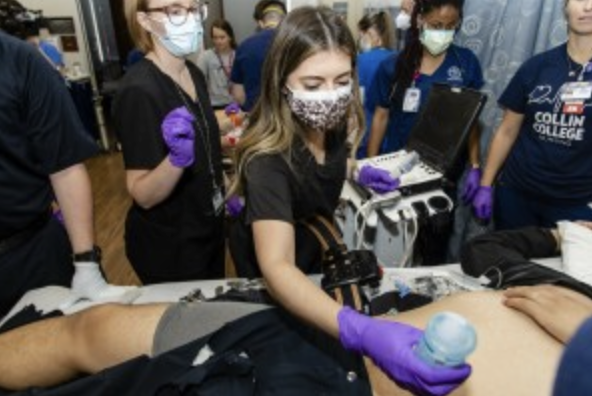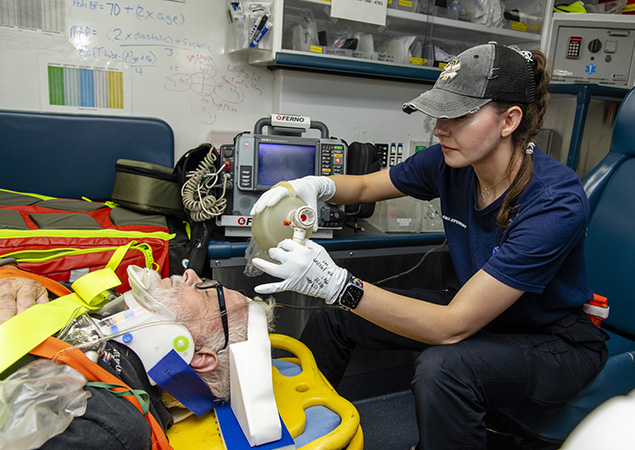“Where's my dog?” the man asks plaintively, if a little loudly. “Y’all seen my dog? What about my bag?”
The man, who appears to be homeless, is lying next to a railroad track with the stump of his left leg covered in blood and severed limb under a train car. The emergency medical services (EMS) students around him try to reassure him while assessing his injury and applying a tourniquet.
A few hundred yards away, inside the Collin College Public Safety Training Center, a meth lab is about to explode. After that, there will be a bank robbery – the second of the day.
Welcome to Trauma Day at Collin College.
In the field
The result of weeks of planning by virtually every program in the Health Sciences
and Emergency Services department, Trauma Day is choreographed chaos designed to test
students in realistic scenarios and reinforce what they have learned in class while
instructors look on and gently guide them.
Trauma Day is a long-running, annual event for the EMS program. This year, students from nursing, respiratory care, surgical technology, sonography, and others joined in the fun.
Students rotate through different scenarios throughout the day, building on the lessons they have been taught in class with an experience as close to real-life as their instructors can make it using volunteer actors and “moulage” – the application of trauma makeup and prosthetics.
“It’s something different,” EMS student Viviane Dao says during a break from the chaos. “It’s nice to have actual patients instead of manikins because it makes it more real.”
Dao and two other students, Michael White and Joshua Ray, just transported a woman with severe burns to her face to the emergency room set up at the McKinney Campus. The woman was nearly incoherent with pain after an explosion in her second-floor “meth lab,” and the students had to determine her injuries without much help from her.
It turns out she also had a gunshot wound which the students found after some encouragement from an instructor.
“We discovered it,” White says. “He kind of guided us, telling us that we needed to do an examination from head to toe.”
The paramedic students in training all agreed that seeing and feeling an injury – even a fake one – gave them a better understanding of their chosen profession.
“That’s what is nice about today,” Dao says. “We get to cut the clothes off, look, and feel, to see what we would actually see. On our lab days, it is a manikin, so we have to ask, ‘What do I see? What do I feel?’ Today the (injury makeup) lets us feel a simulated gunshot wound, a broken bone, and more.”
The Emergency Room
It took a team effort to get the man and his severed limb into an ambulance on loan
from a local hospital. He fought them some of the way.
 Now in the simulated emergency room at the McKinney Campus, he is surrounded by a
beehive of activity. Nurses are assisting with his examination. Sonographers are watching
a nearby patient’s monitors closely. A group of respiratory therapists is working
on a manikin of an infant.
Now in the simulated emergency room at the McKinney Campus, he is surrounded by a
beehive of activity. Nurses are assisting with his examination. Sonographers are watching
a nearby patient’s monitors closely. A group of respiratory therapists is working
on a manikin of an infant.
In addition to the trauma cases being transported from the Public Safety Training Center, walk-in ER patients are presenting with asthma attacks, apparent poisonings, and patients in mental distress.
Dr. Sarah Shaver, a second-year emergency room resident at Parkland Hospital, runs the man’s treatment for traumatic amputation, directing the surrounding medical students. Dr. Shaver and two other Parkland Hospital doctors volunteered for the exercise.
• • •
“I think (patient simulation) is a good way to get exposure to high-stress environments when there is no real downside to it,” Dr. Shaver says later. “There’s no real risk, so it allows you to feel what it would be like in those environments and when you see real pathologies, you are more prepared.”
Dr. Shaver was impressed with the students who had a range of experience, although most had not done any clinical rotations before this year’s Trauma Day.
 Dr. Grant Wallenfelsz, another resident from Parkland who would shortly be examining
a collapsed child in the medical intake room next door, also praised the students
and the simulation actors.
Dr. Grant Wallenfelsz, another resident from Parkland who would shortly be examining
a collapsed child in the medical intake room next door, also praised the students
and the simulation actors.
“I think that it has been great, as real as you can get for a simulation experience. I like the team scenario where you have someone at every level,” Dr. Wallenfelsz says, adding that in an emergency department setting, they have to respond with a team effort.
Tim Mock, director of the EMS program at the college, said that teamwork is one important lesson the students will take away from Trauma Day.
“This (exercise) incorporates all aspects of actual patient care,” he said, noting that some patients go from initial assessment and transportation by paramedic students through examination in the ER by doctors and student nurses, and in some cases, additional care in an operating room. “Our students learn and experience how ‘continuity of care’ works with all aspects from pre-hospital care to in-hospital emergency care.”
Doing so under the pressure of a realistic simulated experience brings the lessons home for all involved.
“We put all the real-world pressure we can on the students to ensure they are making the correct assessments and treatments with these patients,” Mock said.
Recovery
A short time later, the man we met lying beside the train tracks is doing much better.
After assessment and stabilization in the emergency room, he was transported upstairs
to the operating room to surgically close his wound.
Somewhat jovial for someone who has gone through such trauma, he says his name is Scott Harmon and he is a member of the Dallas Amputee Network (DAN). He is one of the many people who served as patients for Trauma Day. According to Mock, the group of patients was made up of friends, relatives, DAN members, and Collin College drama club members.
Harmon is having the trauma makeup and prosthetics, more properly known as “moulage,” removed by Jackie Langford, director of the simulation program at Collin College.
Langford, the master of simulated disaster for Trauma Day, has been at work since 6:30 a.m. and estimates he's applied moulage to about a dozen people, including Harmon. He is surrounded by cases with prosthetic limbs and other tools of the simulation trade. He says he added to the collection recently to make the injuries presented even more lifelike.
“They need as true of an experience as we can offer them,” he says. “The more realistic it is for them, the better they will learn and the better they will retain it.”
That’s one of the reasons Mock and the other Trauma Day organizers reached out to Harmon and DAN. Harmon can lend some realism to the training that would be much harder for someone who is not an amputee.
“God has given me a natural gift of one leg, and if that helps them, then good,” Harmon says. “These guys are so awesome in what they do – saving lives – that I consider it a privilege to come and help.
“They were very good. Very impressive. They handled things very well.”
Harmon says he does not consider himself an actor, but he did his best to inhabit the role, including giving his character a dog that seemed to have run off after his accident. That choice came back later in the day, as he was having his fake skin from the amputation sewn up in the second-floor operating room.
“Suddenly I heard the door slam open, and someone yelled, ‘They found the dog! They found Daisy!’ and to my surprise the whole room erupted into shouts and applause,” Harmon says. “I had no idea how anyone else in surgery even knew about the ‘dog.’”
It’s a light-hearted moment in the midst of a serious exercise, but who is to say that moment won’t stick with the students as well.

